Edison Co. Building (aka One Bunker Hill & CalEdison)
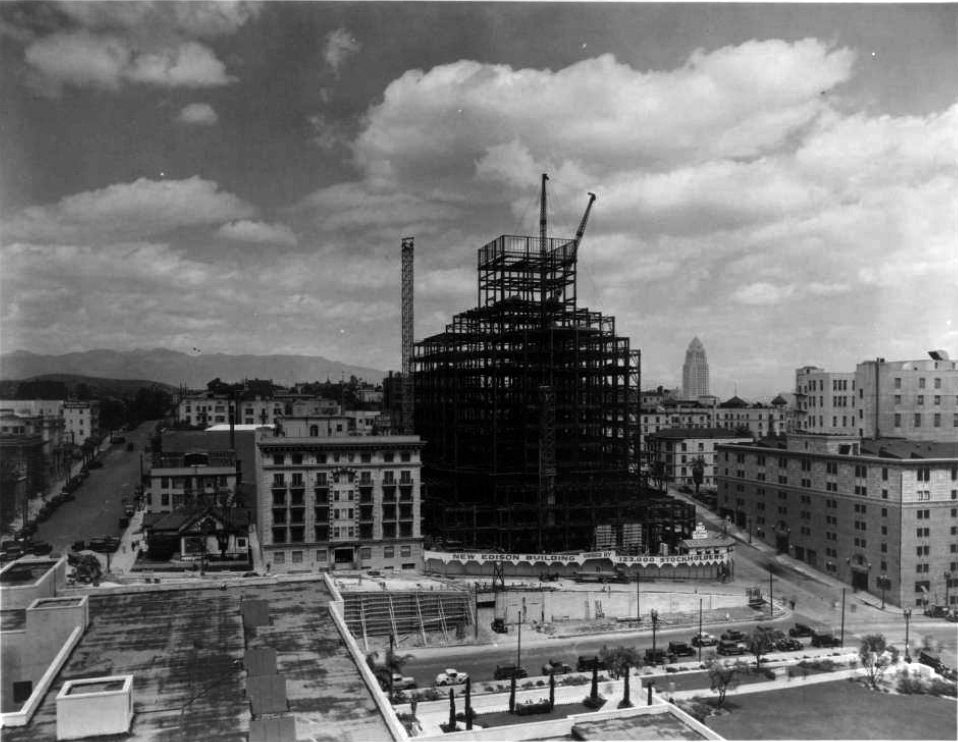 |
|
| (1930)* - View looking north showing the Edison Building under construction at the NW corner of 5th Street and Grand Avenue.City Hall is seen at a distance. |
Historical Notes The above photo was taken from the roof of the Central Library, the still under-construction Edison Building is taking shape. Next door to the left is the handsome, symmetrical Engstrum Hotel Apartments and on the corner of Hope Street is a single family residence and behind it the Pierce Apartments which will soon give way to the Engsrtrum's need for on site parking. Up Hope Street is the white Barbara Worth Apartments shown on the left. |
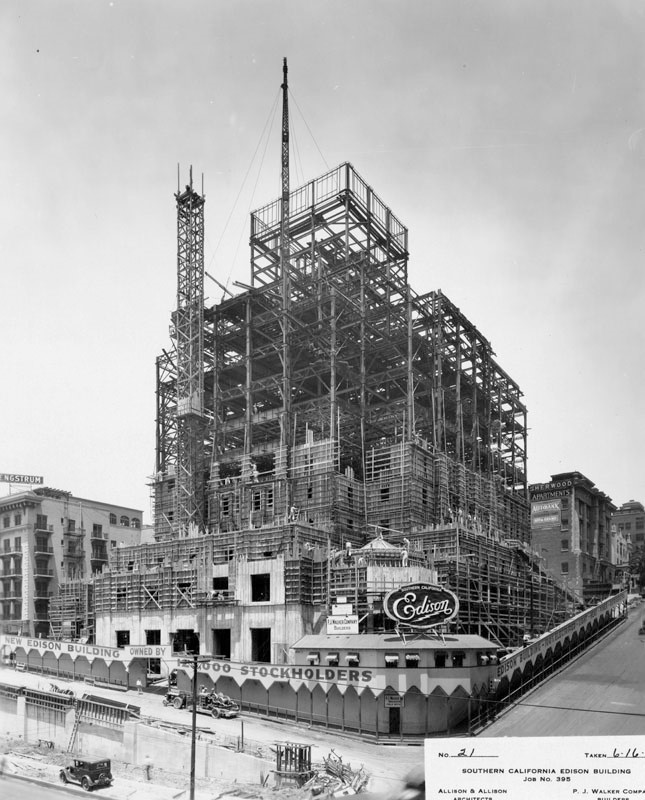 |
|
| (1930)* - View showing the Edison Building during the early stages of construction. Engstrum Hotel Apartments are on the left and the Sherwood Apartments on the right.. |
Historical Notes Located on the corner of Fifth Street and Grand Avenue the building opened on March 20, 1931 as the Southern California Edison Company corporate headquarters. |
 |
|
| (1930)* - View shows the Southern California Edison Company Building in the final stages of construction. |
Historical Notes The Edison Company Building was one of the first all-electrically heated and cooled buildings constructed in the western United States. Now known as One Bunker Hill, the Art Deco building located at 601 W. 5th Street was designed by James and David Allison. |
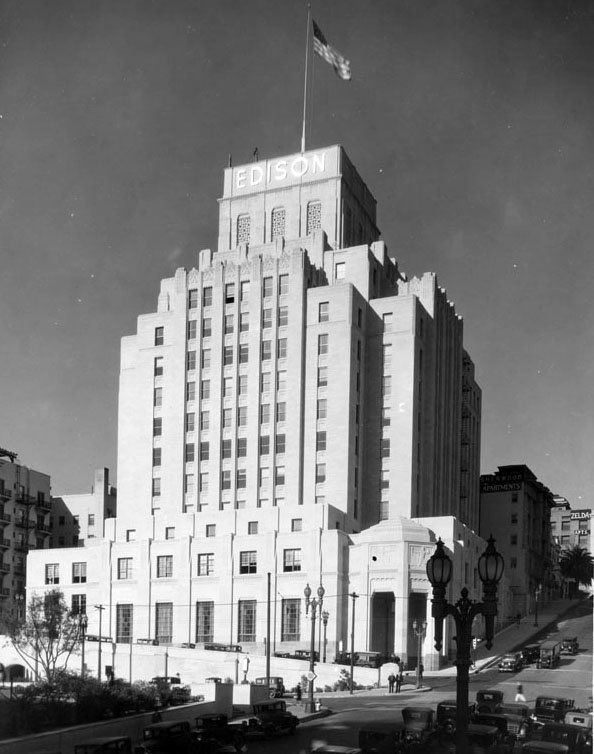 |
|
| (1931)^ - View of the Southern California Edison Building shortly after it was completed. |
Historical Notes The fourteen-story, steel-framed building follows a classically inspired Art Deco design. The lower three stories are of solid limestone, while the upper stories and central tower are faced with buff-colored terra cotta. On the façade, the spandrels contain a cubic Art Deco pattern, repeated in the central tower, lobby floor and elevator ceilings. On the entry façade allegorical figures by sculptor Merrell Gage represent, light, power and hydroelectric energy. In the two-story lobby, classical elements are treated with an Art Deco flavor.* |
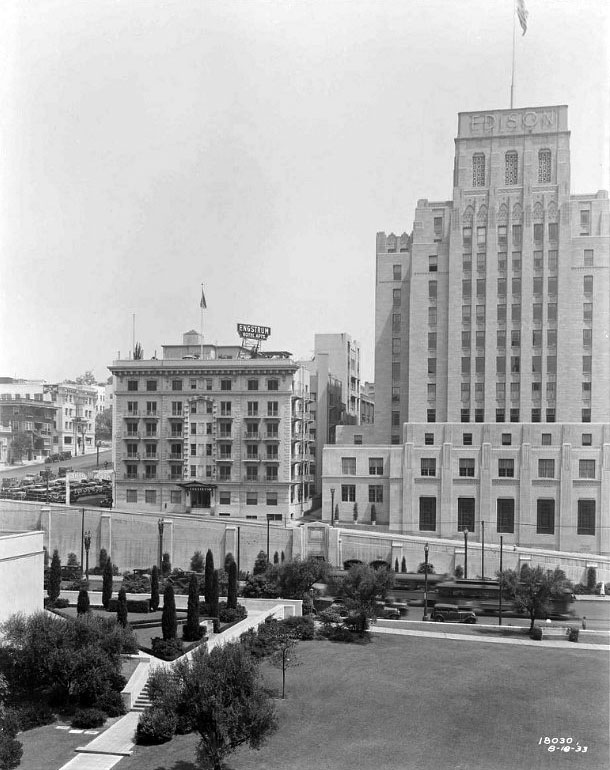 |
|
| (1933)^ - Slightly elevated view, probably from the Mayflower Hotel, looking north across the east library park to the Edison Building, the Engstrum Hotel Apartments, a small slice of the Barbara Worth Apartments, the Wickland Apartments (Rubaiyat), the Santa Barbara Apartments and part of the front of the Sons of the Revolution library. |
Historical Notes In 1939, Southern California Edison (SCE) and the Los Angeles Department of Water and Power (DWP) completed negotiations on the division of territory between the two utilities. SCE would supply the unincorporated areas within Los Angeles County and all other municipalities except for Pasadena, Glendale, and Burbank, while the DWP became the sole electrical service provider for the City of Los Angeles. Click HERE to see more in First Electricity in Los Angeles. |
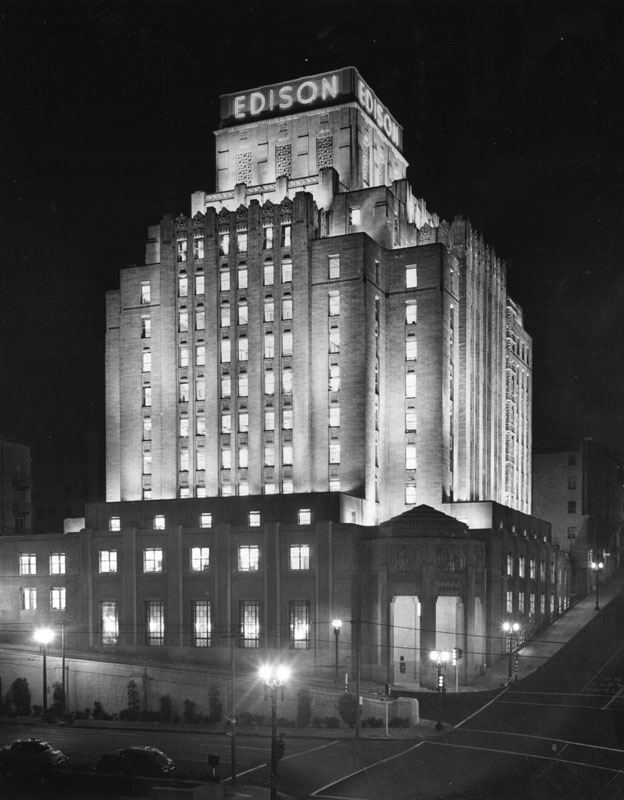 |
|
| (1970)* - Edison Building (later One Bunker Hill) on the northwest corner of Fifth Street and Grand Avenue lighted at night. The Edison Company moved out of this building on August, 15, 1971 to new headquarters in Rosemead, California, and the building and garage were sold to an investment firm. |
Historical Notes In 1988, the One Bunker Hill Building was designated as Los Angeles Historic-Cultural Monument No. 347 (Click HERE to see complete listing). |
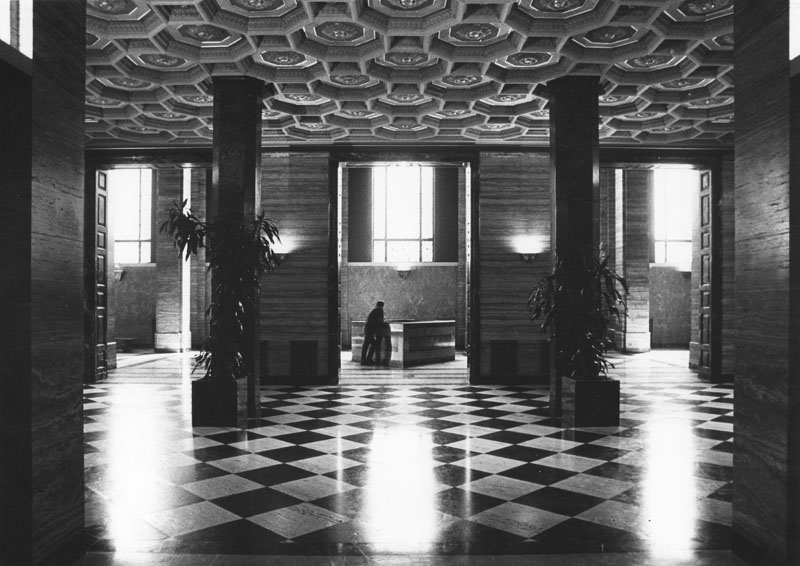 |
|
| (1987)* - The lobby of One Bunker Hill, at Grand and Fifth. The Art Deco building, also called the Edison Building, stands on the NW corner of W. Fifth Street and S. Grand Avenue. It was built from 1930-31 and the architects were Allison & Allison (Austin Whittlesey). |
Historical Notes The building was renamed, The CalEdison. Before that, it was One Bunker Hill. Originally, the 14-story building, which opened in 1931, was the Southern California Edison Building and the headquarters for the Southern California Edison Company. One of the first buildings in the western U.S. with a heating and cooling system powered by electricity, it was, as the New York Times put it, a “monument to energy.” It’s not just the infrastructure; the entry facade features allegorical figures representing light and energy.^ Below the thirty-foot high coffered ceiling, the floor and walls are composed of at least seventeen different types of marble. At the end of the lobby is a mural by Hugo Ballin titled "Power." The exterior greenhouse-like structures were added in the 1980s and the street-level shopping corridor in 1993.* |
* * * * * |
|
Other Sections of Interest |
|
Water and Power in Early LA |
|
Newest Additions |
New Search Index |

A new SEARCH INDEX has been added to help navigate through the thousands of topics and images found in our collection. Try it out for a test run.
Click HERE for Search Index |
* * * * * |
< Back
Menu
- Home
- Mission
- Museum
- Major Efforts
- Recent Newsletters
- Historical Op Ed Pieces
- Board Officers and Directors
- Mulholland/McCarthy Service Awards
- Positions on Owens Valley and the City of Los Angeles Issues
- Legislative Positions on
Water Issues
- Legislative Positions on
Energy Issues
- Membership
- Contact Us
- Search Index
© Copyright Water and Power Associates
Layout by Rocket Website Templates